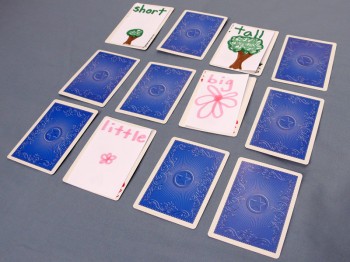Lesson Plans for Elementary School Students
Full Length Lesson Plans from an Elementary School Teacher
Reading Lesson Plan: Opposite-Word Concentration Game
 Based on the familiar game of Concentration, this variation has students quickly learning opposites, increasing their memory, and reading new words. Old decks of playing cards can be used, with a word and picture glued on one side. Students can work with as many pairs as they want. They are placed face down, with two cards drawn in a turn. If a pair is made, the turn continues. Students accumulate pairs by remembering where the matching card is hidden.
Based on the familiar game of Concentration, this variation has students quickly learning opposites, increasing their memory, and reading new words. Old decks of playing cards can be used, with a word and picture glued on one side. Students can work with as many pairs as they want. They are placed face down, with two cards drawn in a turn. If a pair is made, the turn continues. Students accumulate pairs by remembering where the matching card is hidden.
Objective:
- learning opposites (antonyms)
- increasing memory
- reading new words
Materials:
- old deck of playing cards, with an opposite word and picture glued to each face, start with 10 or 20 cards.
- chart paper and marker, to brainstorm opposite words with students
- glue, scissors, small squares of paper that will fit over playing cards, so students can add to the set of opposite cards
Method:
- Before lesson, make up opposite cards. The “Scholastic Dictionary of Synonyms, Antonyms, Homonyms
” book is good for finding more opposite pairs. Glue word and picture to old cards.
Examples:- hot (picture: fire)/cold (picture: icicles)
- big (flower)/little (flower)
- happy (smiling face)/sad (frowning face)
- thin (book)/thick (book)
- in (fish in bowl)/out (fish out of bowl)
- front (guitar)/back (guitar)
- tall (tree)/short (tree)
- asleep (cat)/awake (cat)
- white (colour)/black (colour)
- night (moon)/day (sun)
- Talk with students about the meaning of opposites. Have students brainstorm a list of opposites. Draw small simple pictures beside the opposites. Encourage students to use the old playing cards and pieces of paper to make more opposite cards for the concentration game.
- Show students how to lay cards face down in rows. Turn over two cards at a time. If they match, student gets another turn. Student with the most cards at the end of the game, wins. Two students can play in teams against another two students. Have students begin with 10 cards, or 20. Once they’ve practised a bit, they can add more cards to the game.
- Play the game with the class, encouraging students to call out where the matching pieces are. When the game is over, put cards and materials to make more, in a centre for them to use in their free time. “Reading Skills Card Games: 15 Fun and Easy Reproducible Games That Build
Fundamental Reading Skills” by Liane B. Onish is a great book for games that build reading skills.
Tags: brainstorm, game, memory, opposites
